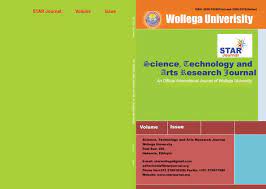Dependence of energy eigenvalue on magnetic field, AB flux and Temperatures of two electron quantum dot (anti dot) confined in Mie potential
DOI:
https://doi.org/10.20372/star.v8i4.02Keywords:
Mie potential, Quantum dot, AB flux fields, Nikiforov-Uvarov method, Schrödinger equationAbstract
The characteristics and energy of a system in an eigenvalue problem can be approximated through different mathematical formalisms, so as we have preferred and employed the Nikiforov-Uvarov formalism to solve for the Mie potential. The energy spectrum is calculated numerically and exposed to external magnetic field intensity, temperature, and AB flux intensity considering material parameters GaAs quantum dot (antidot) confined in Mie potential. The magnetic field and AB flux intensity affect additional confinement potential, which plays a great role in tuning the potential model fit to different applicability and enhances the study of different properties of the system. In our study, we investigated energy spectrum dependence on the repulsive radius, applied magnetic field, AB flux intensity, and rovibrational state to enhance the energy spectrum over dominating the potential confinement, and however, the effect of temperature is governed by the form of confinement potential in maintaining the attractive and repulsive phases. The energy spectrum is highly influenced by the presence of a repulsive anti-dot radius due to electron-electron interactions in the systems.
Downloads
Metrics
References
Akbar Rajabi, A. &. (2013). Relativistic effect of external magnetic and Aharonov- Bohm fields on the unequal scalar and vector Cornell model. The European Physical Journal Plus, 128, 1-6.
Aspnes, D. E. (1976). GaAs lower conduction-band minima: ordering and properties. Physical Review,14(12), DOI:https://doi.org/10.1103/PhysRevB.1 4.5331
Bahar, M. K. (2020). Magneto‐optical specifications of Rosen‐Morse quantum dot with screw dislocation. International Journal of Quantum Chemistry, 120(11), e26186, 1-6.
Bayrak, O. B. (2007). Exact analytical solutions to the Kratzer potential by the asymptotic iteration method . International Journal of Quantum Chemistry, 107(3), 540–544.
Berkdemir, C. B. (2006). Bound state solutions of the Schrödinger equation for modified Kratzer’s molecular potential. Chemical Physics Letters, 417(4-6), 326-329.
Durmus, A. &. (2007). Relativistic and nonrelativistic solutions for diatomic molecules in the presence of double ring- shaped Kratzer potential . The Journal of chemical physics, 126(7), 074108.
Edet, C. O. (2020). Bound state solutions of the schrodinger equation for the modified kratzer potential plus screened coulomb potential. Indian Journal of Physics, 94 (4), 425–433.
Ehrenreich, H. (1961). Band structure and transport properties of some 3–5 compounds. Journal of Applied Physics, 32(10), 2155-2166.
Elabsy, A. M. (2000). Influence of heat on impurity states in an artificial semiconductor atom. Egypt. J. Sol., 23, 267-275.
Hajigeorgiou, P. G. (2006). Exact analytical expressions for diatomic rotational and centrifugal distortion constants for a kratzer–fues oscillator. Journal of Molecular Spectroscopy, 235 (1), 111–116.
Hajigeorgiou, P. G. ( 2006). Exact analytical expressions for diatomic rotational and centrifugal distortion constants for a kratzer–fues oscillator. Journal of Molecular Spectroscopy, 235 (1), 111–116.
Hamzavi, M. R. (2011). Solution of dirac equation with killingbeck potential by using wave function ansatz method under spin symmetry limit. Communications in Theoretical Physics, 55 (1), 35-37.
Hassanabadi, H. M. (2012). Dirac equation for generalized po ´schl-teller scalar and vector potentials and a coulomb tensor interaction by nikiforov-uvarov method. Journal of Mathematical Physics, b53(2), 022104.
Ikhdair, S. &. (2008). On solutions of the Schrödinger equation for some molecular potentials: wave function ansatz. Open Physics, 6(3), 697-703.
Ikhdair, S. M. (2008). Exact bound states of the ddimensional klein–gordon equation with equal scalar and vector ring-shaped pseudo harmonic potential. International Journal of Modern Physics C, 19(9), 1425-1442.
Ikhdair, S. M. (2015). Nonrelativistic molecular models under external magnetic and AB flux fields. Annals of Physics, 353, 282-298.
Ikhdair, S. M. (2012). A quantum pseudodot system with two-dimensional pseudo harmonic oscillator in external magnetic and Aharonov-Bohm fields. Physical B: Condensed matter, 407 (21), 4198-4207.
Ikhdair, S. M. (2012). A quantum pseudodot system with two-dimensional pseudo harmonic oscillator in external magnetic and Aharonov-Bohm fields. Physica B:Condensed matter,407 (21), 4198- 4207.
Ikhdair, S. M. (2015). Nonrelativistic molecular models under external magnetic and AB flux fields. Annals of Physics, 353, 282-298.
Ikot, A. O. (2019). Eigen solution, expectation values and thermodynamic properties of the screened kratzer potential. The European Physical Journal Plus, 134(8), 1-18.
LeRoy, R. J. (1970). Dissociation energy and long-range potential of diatomic molecules from vibrational spacings of higher levels. The Journal of Chemical Physics, 52(8), 3869-3879.
Liboff, R. L. (2003). Introductory quantum mechanics. Pearson Education . India.
Macke, W. (1961). Problems in quantum mechanics. Oxford/London/new york/Paris: Festschrift Angewandte.
Morse, P. M. (1929). Diatomic molecules according to the wave mechanics. ii. vibrational levels. Physical review, 34(1), 57.
Nikiforov, A. F. & Uvarove, V.B. (1988). Special functions of mathematical physics.
Oyewumi, K. A. (2008). Exactly complete solutions of the pseudo harmonic potential in n-dimensions. International Journal of Theoretical Physics 47(4), 1039-1057.
Sadeghi, J. (2007). Factorization method and solution of the non-central modified Kratzer potential. Acta Physica Polonica Series A, 112(1), 23.
Sever, R. B. ( (2007).). Bound state solution of the Schrodinger equation for Mie potential. arXiv preprint quant- ph/0701227.
Weissman, Y.E. (1979). The isotonic oscillator. Physics Letters A, 70(3), 177- 179
Downloads
Published
How to Cite
License
Copyright (c) 2019 Journal of Science, Technology and Arts Research

This work is licensed under a Creative Commons Attribution-NonCommercial 4.0 International License.
STAR © 2023 Copyright; All rights reserved





